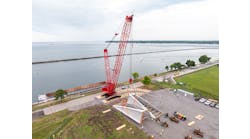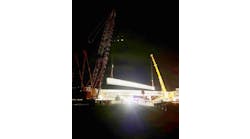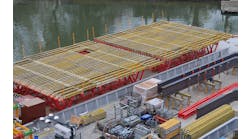By: Allen Zeyher
It took nearly 10 years, but Bangkok, Thailand, now has a fifth bridge crossing the Chao Phraya River at the center of the city. The bridge is intended to relieve traffic congestion on the nearby Pinklao Bridge and serve as a memorial to King Rama VIII, the late brother of the current Thai king, who ruled for a short time.
The Engineers' Society of Western Pennsylvania, in association with Roads & Bridges, awarded the Eugene C. Figg Jr. Medal to Buckland & Taylor Ltd., North Vancouver, British Columbia, for the company's work on the Rama VIII Bridge. The Figg Medal is given for a single, recent outstanding achievement in bridge engineering that, through vision and innovation, provides an icon to the community for which it was designed. The medal was presented at the International Bridge Conference in Pittsburgh on June 9.
The bridge's owner is the Bangkok Metropolitan Administration. The owner's engineer was Mott-MacDonald of the U.K, and the architect for the outline design was Yee Associates of London. The design-build contract was awarded to a joint venture headed by China State Construction & Engineering Corp. and BBR Systems Ltd. with engineering services provided by Scott Wilson Kirkpatrick Ltd., which did site design coordination, site inspection and geotechnical design, Asdecon Corp., which did mechanical and electrical design, and Buckland & Taylor. Buckland & Taylor provided the detailed design of the cable-stayed main span and the construction engineering services for its erection. In addition, the owner retained Prof. Bundit Chulasai of Chulalongkorn University's architecture department to provide architectural input at the detailed design stage.
The China State joint venture had to work harder than usual to win the design-build contract. The project was first tendered in 1996. The China State team had the lowest bid but lost the contract to another team on the basis of points scored in the bid evaluation. Shortly thereafter, the Asian economy took a dive, taking the Thai baht with it, and the bridge proj-ect was shelved.
When it was revived in 1998, China State put together another joint venture and won the contract. Construction began in 1999 and was completed in 2002. The bridge opened to traffic in March 2002 and was officially dedicated by King Rama IX on Sept. 20, King Rama VIII's birthday.
Dealing from three decks
Rama VIII is the world's largest asymmetric cable-stayed bridge.
The bridge is 475 m long, with a 300-m main span, two 50-m back spans and a 75-m anchor span. The whole thing is supported by a single 160-m-tall tower with an inverted-Y shape.
A lot of cable-stayed bridges employ one deck system for the whole length of the bridge, but that was not the case with the Rama VIII Bridge.
"In this case, because of the constraints on the structure, we've got three different kinds of deck systems along the deck," Don Bergman, vice president of Buckland & Taylor, told Roads & Bridges.
The main span consists of a light steel frame supporting precast concrete deck panels and a 50-mm asphalt driving surface. The asphalt can be ground off and replaced when the traffic surface needs rebuilding.
The main-span deck is 29.2 m wide, accommodating two lanes of traffic in each direction, with a 5.3-m-wide sidewalk for pedestrians and cyclists on each side. The anchor span is 28.4 m wide, carrying three lanes of traffic each way.
Composite panels enclose the underside of the main-span deck to give it a neater look. The owner wanted to simulate the clean appearance of a closed box girder without the associated higher cost. The enclosure also provides a dehumidified atmosphere to protect the steel of the structure.
"And then we've got two different kinds of post-tensioned concrete box structures in the land spans," added Bergman. "Because they're short, we've chosen to make them heavy to counterbalance the longer, lighter main span." The anchor span was especially inventive. "Basically, it's like a full-depth block concrete box girder, but in order to get the weight to balance the main span, we couldn't put all that weight in the back span initially because it would have governed the pile design. We essentially had to fill the concrete box with concrete as the main span was constructed to sort of counterbalance the added weight of the main span."
Sense of place
The tower of the Rama VIII Bridge is not unusually tall for a cable-stayed bridge, but it literally towers over the surrounding area of the historic district of Bangkok on the east bank of the river and Thon Buri on the west bank.
Actually, the tower is taller than it might have been if there had been a second tower. The designers decided not to place a tower on the Bangkok side of the river because it might overshadow the historic Ban Khunprom Palace, a 93-year-old structure immediately north of the bridge on the Bangkok side of the river. The palace is intimately associated with Thailand's transition to a constitutional monarchy in 1932 and is Thailand's only monetary museum.
The Bank of Thailand also objected to placing a bridge tower on the Bangkok side of the river. It worried that the construction activities might cause vibrations that would disturb the delicate task of printing Thai money, known as the baht, at a building immediately south of the bridge site.
Single-tower asymmetry is just one of the design features of the Rama VIII Bridge that were influenced by the unique conditions and culture of Bangkok, where public buildings and monuments are traditionally ornamented with symbolic, commemorative or inspirational features.
The earlier Rama IX Bridge over the Chao Phraya River connecting Bangkok and Thon Buri was something of a public disappointment because it did not well reflect the Thai culture. That cable-stayed bridge was criticized for being a transplanted international design rather than a distinctly Thai design that reflected the importance of Thai art in daily life.
"Technically it's a very good bridge, and it's a very good addition to the traffic system there, but the bridge really was not very well received by the Thai public," said Bergman. "It's fairly stark. It's perhaps a clean European design. There's nothing about it that the Thai people could really relate to."
The king wanted the Rama VIII Bridge to be an important structure. "He also wanted it to reflect Thai traditions and Thai culture in a meaningful way," said Bergman.
In fact, aesthetic merit was so important that the owner of the bridge, the Bangkok Metropolitan Administration, commissioned Prof. Bundit Chulasai of Chulalongkorn University's architecture department to provide architectural design input.
"He was in fact essentially a part of the design team and was quite involved in working on the details," said Bergman. "I think he played an important role in the look and flavor of the bridge."
Bundit figured out that he could use the inverted-Y shape of the tower to symbolize a Bodhisattva seated on a lotus. The triangular space between the legs of the tower represents the seated Buddha, through the inclusion of gilded architectural details on each leg of the tower halfway between the deck and the junction of the legs. In Buddhist canon, the Buddha had 10 previous lives before becoming Buddha. Bodhisattva refers to the life in which he gave away his eyes.
Bundit also suggested the gilded lotus-bud filial that sits atop the tower and is repeated along the cast aluminum handrail.
Octagonal concrete enclosures around the legs of the tower represent an elephant's feet.
The stay cables are finished in a gold color to harmonize with other gilded elements and to reflect the lighting at night.
Golden threads
The cables are arranged in a twin array from the tower in a semifan configuration to support the main span. On the other side, a single set of cables in a near-harp configuration connects the tower to the anchor block below the anchor span. To minimize post-tensioning in the tower, most of the 84 stay cables are anchored into a single wall instead of the typical two walls.
The area of the Rama VIII Bridge is not terribly challenging as far as wind or seismicity, but the engineering process still required analysis of these two factors. Considering wind, for example, the engineers selected a deck type as part of the conceptual design, then numerically modeled the entire bridge with that deck in a computer.
"From that modeling, we get the dynamic properties of the structure, the natural frequencies that the structure wants to vibrate," explained Bergman. "It's almost like a string on a guitar; if you pluck it, it vibrates at a certain rate. It's the same with a bridge only on a much larger scale. If you pluck it, it will vibrate in certain ways."
With the dynamic properties of the bridge, the engineers built a small section of the bridge in real materials on a scale of about 50:1 and mounted it in a wind tunnel on a set of springs carefully tuned to match the natural dynamic properties that were calculated in the numerical model.
"Then we blow the wind on it," continued Bergman, "and we record the behavior of it. We increase the wind until the deck goes unstable. When the deck becomes unstable that's what we call the critical wind speed. That critical wind speed has to be reasonably above the maximum expected wind speed for the site."
There are other types of wind effects the engineers look at as well.
Bangkok sits on a flood plain composed of alternate layers of clays and sands, with the lower layers densely compacted. The deposits extend over 1 km deep, so it was not possible to found piles on bedrock. The constructors used 1.5-m-diam. cast-in-drilled-hole concrete piles about 50 m deep. The support for the piles is provided partly by friction and partly by load-bearing.
As Rama VIII Bridge is deeply rooted in the alluvial deposits of Bangkok, it also is deeply rooted in Thai culture brought into the modern concerns of trying to relieve traffic congestion. The bridge stands as a testament to modern engineering with a traditional flavor.
About The Author: Allen Zeyher is associate editor of Roads & Bridges.


